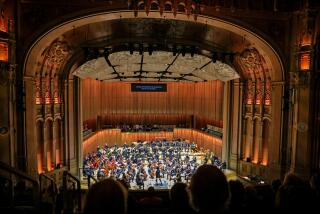Mischief and mastery from Mester’s ensemble
- Share via
Conductor Jorge Mester took the Pasadena Symphony from the exciting to the routine in a three-part program Saturday at the Pasadena Civic Auditorium.
Rodion Shchedrin’s Concerto for Orchestra No. 1 (“Naughty Limericks”) served as a perky curtain raiser. Inspired by satirical folk songs, often of a political bent, from the regions of Belarus and Ukraine, the work might be more accurately titled “Mischievous Folk Ditties.”
But what’s in a name? The piece is lots of fun, full of chattering winds and raucous interjections from the brass, all above jazzy motor rhythms, a bit like a Russian “El Salon Mexico.” But better as a lovely melody in the strings suddenly began rising above the fray and crested into a full-orchestra statement that pulled all the previous virtuosic elements together.
Bartok’s Second Violin Concerto begins with one of the most memorable, bewitching melodies of the 20th century, played above quiet harp chords by the soloist. Violinist Philip Quint played it warmly and with intensity, a down payment on the blazing performance he turned in.
The collaboration between Quint and Mester was tight, especially evident in the precision with which they ended the first movement. But after a magical slow movement, things began to turn vague. They ended the work one beat out of sync.
Maybe the concentration necessary for Bartok’s difficult concerto took a toll. The concert closed with a surprisingly one-dimensional performance of Dvorak’s “New World” Symphony.
Mester seemed more concerned with tempo and dynamic than with phrasing. As a result, the work emerged with little character or feeling.
Additionally, he paid insufficient care to bringing out middle or lower parts. He would focus on one line or part, but not the cross-section of events related to and commenting on it.
It was broad but not deep, and a sometimes crude-sounding performance of a rich, beloved score.
More to Read
The biggest entertainment stories
Get our big stories about Hollywood, film, television, music, arts, culture and more right in your inbox as soon as they publish.
You may occasionally receive promotional content from the Los Angeles Times.










